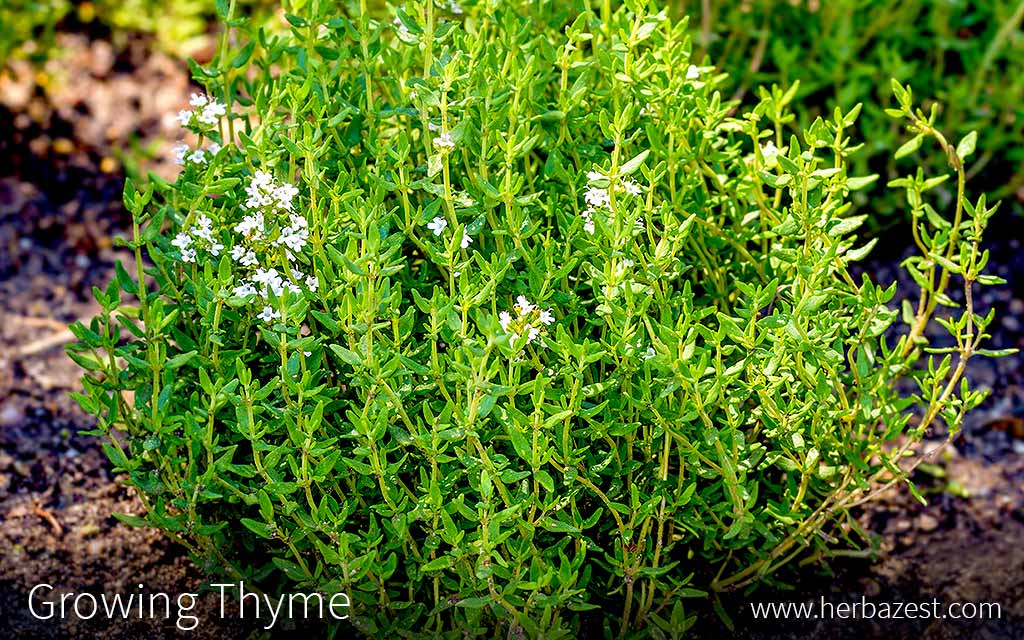Rosemary & Thyme: Growing Your Own Herbs

Table of Contents
Choosing the Right Rosemary and Thyme Varieties
Selecting the appropriate rosemary and thyme varieties is crucial for success. Different varieties boast unique characteristics, thriving in various climates and growing conditions. Consider your space, climate, and desired flavor profiles when making your choices.
Popular Rosemary Varieties:
- Prostrate Rosemary: A low-growing, spreading variety ideal for ground cover or containers. Its delicate flavor is excellent in salads and as a garnish.
- Tuscan Blue Rosemary: Known for its intensely fragrant, needle-like leaves and robust flavor, perfect for roasting meats and making infused oils.
- Arp Rosemary: A vigorous upright grower with a strong, slightly camphoraceous flavor, suitable for larger gardens.
- Miss Jessopp's Upright Rosemary: A compact, upright variety that's easy to maintain and perfect for containers or smaller spaces.
- Golden Rain Rosemary: A visually striking variety with golden-yellow foliage and a milder flavor, adding a touch of elegance to any garden.
Popular Thyme Varieties:
- English Thyme (Common Thyme): A classic thyme with a versatile, slightly lemony flavor, ideal for general cooking and meat dishes.
- Lemon Thyme: Offers a zesty, lemony aroma and flavor, excellent in salads, soups, and poultry dishes.
- Creeping Thyme: A ground-covering variety with a milder flavor, perfect for rock gardens or walkways.
- Caraway Thyme: Provides a unique flavor with hints of caraway, making it a delicious addition to breads and stews.
- Orange Thyme: A striking variety with vibrant orange-tinged foliage and a citrusy fragrance, adding a beautiful and flavorful accent to your garden.
For a wider selection and to purchase seeds or seedlings, check out reputable online nurseries such as [insert links to reputable nurseries].
Sowing Seeds or Planting Seedlings: Your Choice for Growing Herbs
You can grow rosemary and thyme from seeds or by planting established seedlings. Each method offers advantages and disadvantages.
Starting from Seeds:
- Step-by-step guide:
- Sow seeds indoors 6-8 weeks before the last expected frost in small pots filled with well-draining seed-starting mix.
- Plant seeds about ¼ inch deep and cover lightly with soil.
- Keep the soil consistently moist but not soggy.
- Provide ample sunlight (at least 6 hours per day).
- Transplant seedlings outdoors after the last frost, when they have several sets of true leaves.
Transplanting Seedlings:
- Step-by-step guide:
- Choose healthy seedlings with vibrant green leaves and no signs of disease.
- Dig a hole slightly larger than the seedling's root ball.
- Gently remove the seedling from its container, ensuring not to damage the roots.
- Place the seedling in the hole and fill in with soil, firming gently around the base.
- Water thoroughly after planting.
Protecting young plants from pests and diseases is crucial; regularly inspect for signs of infestation and take appropriate action.
Providing Optimal Growing Conditions for Rosemary and Thyme
Rosemary and thyme thrive with proper care, ensuring vigorous growth and flavorful harvests.
- Sunlight: Both herbs need at least 6-8 hours of direct sunlight daily.
- Soil: Well-drained soil is crucial; amend heavy clay soil with compost or perlite to improve drainage. A slightly alkaline pH (6.0-7.5) is ideal.
- Watering: Water regularly, especially during dry spells, but avoid overwatering, which can lead to root rot. Allow the soil to dry slightly between waterings.
- Fertilizing: Rosemary and thyme are relatively low-maintenance; a light application of balanced, organic fertilizer in spring is usually sufficient.
- Pruning: Regular pruning encourages bushier growth and prevents legginess. Pinch back tips of stems to promote branching and maintain a compact shape.
Harvesting and Preserving Your Rosemary and Thyme
Harvesting at the right time maximizes flavor and aroma.
- Best time to harvest: Harvest rosemary and thyme just before flowering, typically in late spring or early summer. You can continue harvesting throughout the growing season.
- Harvesting techniques: Snip or cut stems, leaving about one-third of the plant's growth. This encourages continued growth and bushier plants.
- Air Drying: Bundle stems together and hang them upside down in a cool, dark, well-ventilated area for 1-2 weeks.
- Oven Drying: Spread herbs thinly on a baking sheet and dry in a low oven (170°F/77°C) for 1-2 hours, checking frequently to prevent burning.
- Freezing: Chop fresh herbs and freeze them in ice cube trays with a little water or olive oil for convenient use later.
Conclusion: Start Growing Your Own Rosemary and Thyme Now!
Growing your own rosemary and thyme is a rewarding experience, bringing the fragrant beauty and culinary delights of these herbs directly to your kitchen. By following these simple steps, you can easily cultivate a thriving herb garden, enjoying the fresh flavors in your cooking and the aromatic benefits throughout your home. Start growing your own rosemary and thyme now! Begin your herb garden journey today with rosemary and thyme! Discover the joy of homegrown rosemary and thyme and the ease of herb cultivation. Visit [insert links to resources, such as seed suppliers or gardening guides] for additional information and supplies.

Featured Posts
-
 Lasana De Calabacin La Receta Sencilla De Pablo Ojeda En Mas Vale Tarde
May 31, 2025
Lasana De Calabacin La Receta Sencilla De Pablo Ojeda En Mas Vale Tarde
May 31, 2025 -
 Indian Wells Quarterfinals Swiatek Triumphs Over Challenging Conditions
May 31, 2025
Indian Wells Quarterfinals Swiatek Triumphs Over Challenging Conditions
May 31, 2025 -
 Tuesday Weather In Northeast Ohio Sunny Skies And Dry Spell
May 31, 2025
Tuesday Weather In Northeast Ohio Sunny Skies And Dry Spell
May 31, 2025 -
 Miley Cyrusin Bruno Mars Plagiointisyytteet Tuomio Odottaa
May 31, 2025
Miley Cyrusin Bruno Mars Plagiointisyytteet Tuomio Odottaa
May 31, 2025 -
 Saint Die Des Vosges Participez Au Game De Dahu 1
May 31, 2025
Saint Die Des Vosges Participez Au Game De Dahu 1
May 31, 2025
